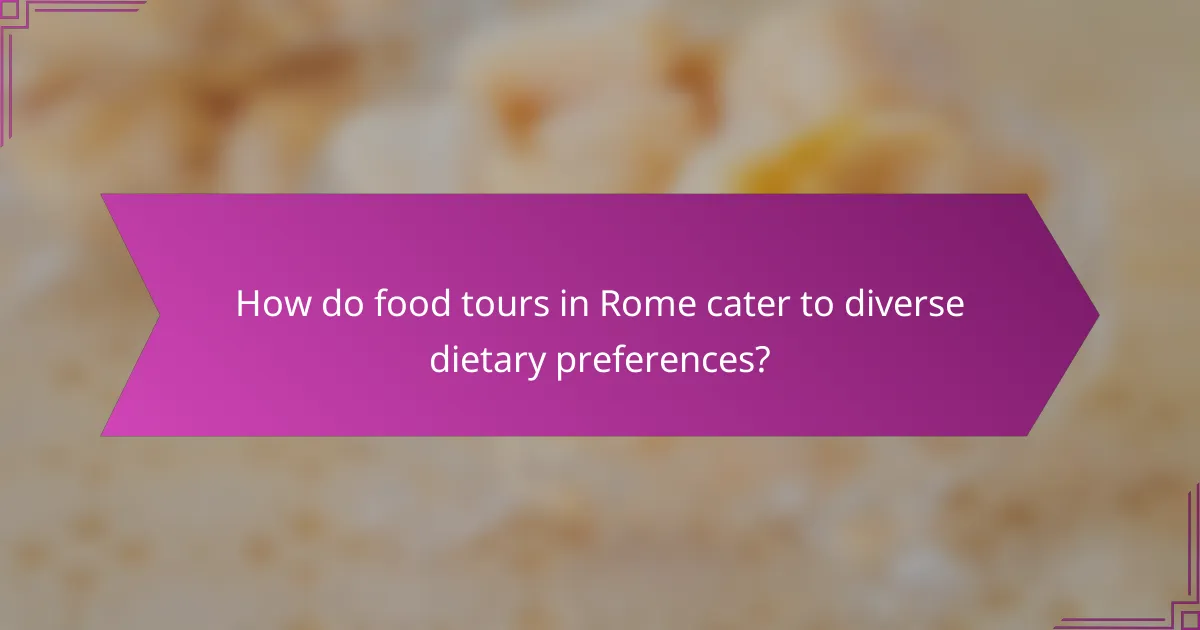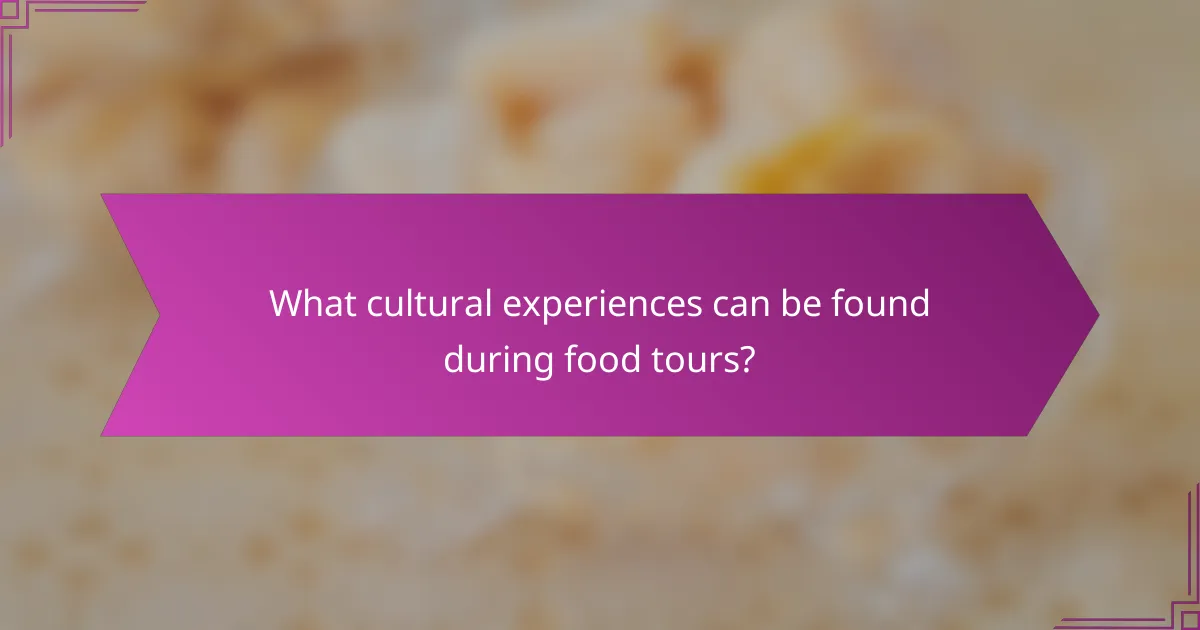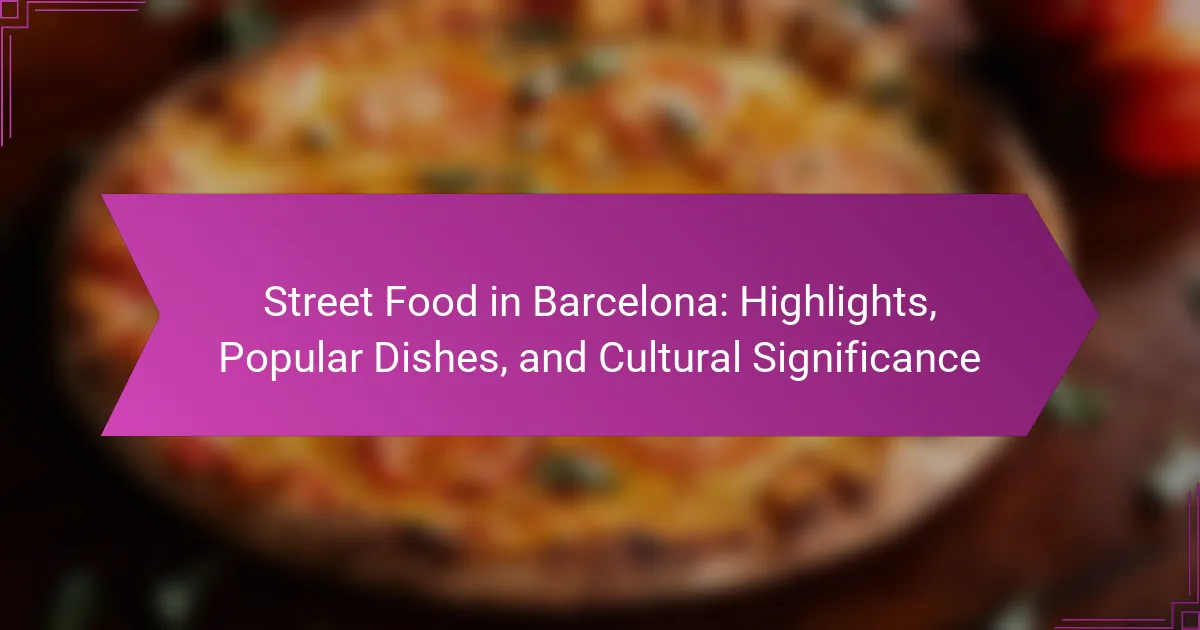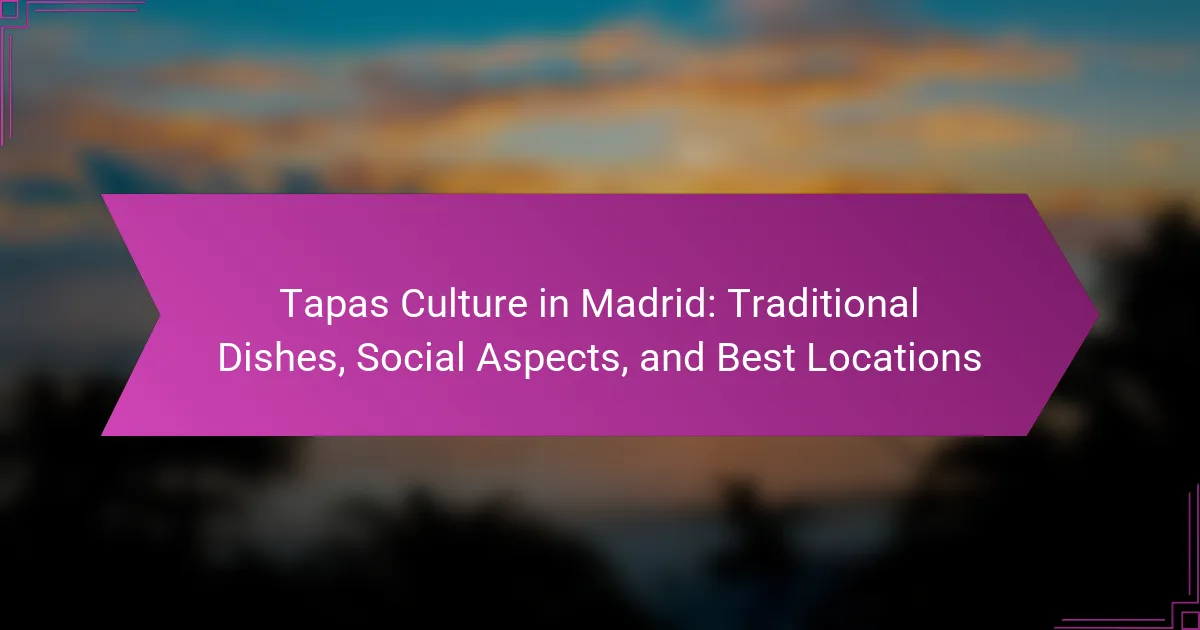Food tours in Rome provide an immersive way to experience authentic cuisine and local culture. Discover personalized itineraries with local guides, indulge in must-try dishes like pasta and gelato, and explore unique markets and family-owned eateries. These tours cater to diverse dietary preferences, ensuring inclusivity while showcasing the richness of Roman culinary traditions. Engage in memorable activities, from cooking classes to night tours, that deepen your understanding of Rome’s gastronomic heritage.

What are the key features of food tours in Rome?
Food tours in Rome offer authentic experiences, local guides, and must-try dishes. Key features include personalized itineraries, cultural insights, and tastings of iconic foods like pasta and gelato. Tours often highlight unique local markets and family-owned eateries, providing a deeper connection to Roman culinary traditions. Engaging with knowledgeable guides enhances the experience, making it memorable and educational.
How do local guides enhance the food tour experience?
Local guides significantly enhance food tours by providing insider knowledge and authentic experiences. They share personal stories about local cuisine and culture, creating a deeper connection to the food. Guides often lead participants to hidden gems, ensuring visitors taste traditional dishes that may not be found in touristy areas. Their expertise helps travelers navigate local dining customs, enriching the overall experience. Engaging with knowledgeable locals fosters a sense of community and appreciation for the culinary heritage of Rome.
Which must-try dishes are included in popular food tours?
Food tours in Rome feature must-try dishes like pasta carbonara, supplì, and tiramisu. These dishes showcase authentic Roman flavors and local culinary traditions. Tourists often enjoy sampling classic street food such as porchetta sandwiches and pizza al taglio, which enhance the local experience. Additionally, gelato is a staple, offering a refreshing treat after exploring the city.
What types of food tours are available for different tastes?
Food tours in Rome cater to various tastes, offering diverse experiences for every palate. Options include traditional cuisine tours, gourmet food experiences, and vegetarian or vegan-focused tours.
Traditional cuisine tours showcase must-try dishes like pasta carbonara and Roman-style pizza, guided by locals who share their culinary heritage. Gourmet food experiences highlight high-end dining and artisanal products, allowing participants to savor luxury flavors. Vegetarian and vegan tours focus on plant-based dishes, featuring local markets and innovative culinary techniques.
These food tours provide authentic interactions with local guides, ensuring a rich cultural experience alongside delicious meals.

How do food tours in Rome cater to diverse dietary preferences?
Food tours in Rome cater to diverse dietary preferences by offering customized experiences. Many tours provide vegetarian, vegan, gluten-free, and dairy-free options. Local guides often have knowledge of specific dietary needs and can recommend suitable restaurants and dishes. This adaptability enhances the authenticity of the culinary experience while ensuring inclusivity for all participants. Food tours also frequently highlight local ingredients, which can accommodate various dietary restrictions while showcasing the region’s culinary richness.
What options are available for vegetarians and vegans?
Food tours in Rome offer a variety of vegetarian and vegan options. Local guides provide experiences featuring plant-based dishes, including pasta, pizza, and traditional antipasto.
Vegetarian options typically include dishes like cacio e pepe, caprese salad, and seasonal vegetable risottos. Vegan choices often feature dishes such as artichoke alla Romana and various bruschetta topped with fresh tomatoes and basil.
Many food tours also accommodate dietary restrictions, ensuring that participants enjoy authentic Roman cuisine without compromising their values. This commitment to inclusivity enhances the overall experience for vegetarians and vegans.
How do food tours accommodate gluten-free diets?
Food tours in Rome can accommodate gluten-free diets by offering tailored options and local insights. Many tour operators provide gluten-free alternatives to traditional dishes. They often collaborate with restaurants that specialize in gluten-free cuisine, ensuring safe and enjoyable experiences. Additionally, local guides are knowledgeable about gluten-free ingredients and can help navigate menus effectively. This customization enhances the authenticity of food tours while prioritizing dietary needs.

What cultural experiences can be found during food tours?
Food tours in Rome offer diverse cultural experiences that highlight local traditions, cuisine, and history. Participants engage with local guides who share insights into culinary practices, regional ingredients, and historical contexts of dishes.
Tour activities often include visits to markets, cooking classes, and tastings of authentic dishes like pasta, pizza, and gelato. These experiences foster a deeper understanding of Roman culture and its gastronomic heritage.
Unique attributes of food tours include opportunities to meet local artisans and chefs, enhancing the overall experience. Rare encounters may involve special events, such as food festivals or seasonal fairs, showcasing traditional recipes and local flavors.
How do food tours connect participants with local culinary traditions?
Food tours connect participants with local culinary traditions by offering immersive experiences led by knowledgeable guides. These tours showcase authentic dishes, preparation methods, and the cultural significance behind each meal. Participants engage directly with local chefs and vendors, fostering a deeper appreciation for regional flavors. This hands-on approach to learning enhances the connection to culinary heritage, making each tour a unique exploration of Rome’s rich food culture.
Which neighborhoods are known for their unique food tour experiences?
Trastevere, Testaccio, and Campo de’ Fiori are neighborhoods known for unique food tour experiences in Rome. Trastevere offers charming streets and authentic trattorias. Testaccio is famous for its traditional Roman cuisine and local markets. Campo de’ Fiori features vibrant food stalls and culinary history. Each area provides distinct flavors and insights into Roman culture.

What are the benefits of booking a food tour in advance?
Booking a food tour in advance ensures you secure a spot with a local guide, enhancing your experience. Early reservations provide access to exclusive tastings and popular tours that may fill quickly. Additionally, planning ahead allows for better itinerary management, ensuring you can enjoy must-try dishes without last-minute stress. Finally, advance booking often offers better pricing options, saving you money on your culinary adventure.
How can early booking influence the selection of dishes?
Early booking significantly enhances the selection of dishes on food tours in Rome. It allows participants to secure spots at popular venues known for authentic local cuisine. Early reservations often provide access to exclusive experiences, such as chef-led tastings or special menus not available last minute. Additionally, booking in advance can lead to better pricing and availability of sought-after tours that feature must-try dishes.
What is the impact of seasonal availability on food tours?
Seasonal availability significantly impacts food tours by influencing the variety and quality of local ingredients. During peak seasons, tours often feature fresh, vibrant produce and traditional dishes that highlight local culinary culture. For instance, summer tours may showcase ripe tomatoes and fresh basil, while winter tours may focus on hearty, warming dishes. Local guides can provide insights into seasonal specialties, enhancing the authenticity of the experience. As a result, food tours adapt to seasonal changes, offering unique culinary experiences throughout the year.

Why are small group tours preferred over larger ones?
Small group tours are preferred over larger ones because they offer personalized experiences and greater interaction with local guides. Travelers enjoy the intimacy of smaller groups, which enhances the authenticity of food tours in Rome. Participants can engage more deeply with the culture and cuisine, leading to memorable culinary experiences. Additionally, smaller groups allow access to hidden gems and local eateries that larger tours may overlook.
What advantages do intimate settings provide during tastings?
Intimate settings during tastings enhance the overall experience by fostering deeper connections and engagement. They create a relaxed atmosphere, allowing participants to savor flavors while enjoying personal interactions with local guides. This setting often leads to more meaningful discussions about the food, its origins, and cultural significance. Additionally, smaller groups enable tailored experiences, ensuring that individual preferences and questions are addressed effectively.
How do small groups enhance interaction with local guides?
Small groups enhance interaction with local guides by fostering personal connections and tailored experiences. These intimate settings allow guides to share unique insights about Rome’s culinary culture. Participants can ask questions, engage in discussions, and receive personalized recommendations, enriching their food tour experience. Additionally, smaller groups facilitate a relaxed atmosphere, encouraging open communication and deeper engagement with the local cuisine.

What are some unique food tour experiences that stand out?
Food tours in Rome offer unique experiences that highlight authentic cuisine and local culture. One standout experience is a guided tour through Trastevere, where participants can sample traditional dishes like cacio e pepe and supplì. Another exceptional option is a market tour at Campo de’ Fiori, allowing visitors to interact with local vendors and taste fresh ingredients. Cooking classes combined with market visits provide hands-on opportunities to create classic Roman dishes. Additionally, night tours reveal the vibrant street food scene, featuring delicacies like pizza al taglio and gelato.
Which tours feature exclusive access to local markets?
Food tours in Rome often include exclusive access to local markets, enhancing the authentic culinary experience. These tours typically feature guided visits to bustling markets such as Campo de’ Fiori and Testaccio Market. Participants can sample local delicacies, interact with vendors, and learn about traditional Roman ingredients. Such exclusive access allows for a deeper understanding of Rome’s food culture and unique attributes, like seasonal offerings and artisanal products.
What rare culinary experiences can be found on specialized tours?
Rare culinary experiences on specialized food tours in Rome include tasting ancient Roman recipes, exploring regional wines not widely available, and sampling unique street foods. Local guides often introduce hidden gems like family-run trattorias and artisan markets. These experiences showcase local culture and traditions, offering a deeper understanding of Rome’s culinary heritage.

How can participants maximize their enjoyment on a food tour?
To maximize enjoyment on a food tour, participants should engage actively with local guides and embrace the culinary culture. Try to ask questions about the dishes and their history. Sample a variety of foods to experience diverse flavors.
Consider taking notes or photos of favorite dishes to remember them later. Arrive hungry to fully appreciate the tastings offered. Stay open to trying new foods, as local guides often introduce unique regional specialties.
What are the best practices for engaging with local guides?
To engage effectively with local guides during food tours in Rome, prioritize clear communication and respect for their expertise. Establish a friendly rapport by asking open-ended questions about local dishes and traditions. Encourage them to share personal stories, enhancing the authenticity of the experience. Be open to recommendations and flexible with your itinerary, allowing for spontaneous discoveries. Show appreciation for their insights, which fosters a positive interaction.
Which common mistakes should be avoided during food tours?
To enhance your food tour experience in Rome, avoid these common mistakes. Ignoring local recommendations can lead to missed authentic dishes. Over-scheduling can cause stress and limit enjoyment of each tasting. Failing to ask questions about food origins may diminish appreciation. Not budgeting for tips can create awkward moments with guides. Lastly, neglecting to try street food can mean missing out on local culinary gems.
What tips can enhance the overall food tour experience?
To enhance your food tour experience in Rome, engage with local guides, savor authentic dishes, and immerse yourself in the culture. Prioritize small group tours for intimate settings. Ask questions to deepen your understanding of the food’s history and preparation. Take notes on your favorite dishes for future reference. Explore off-the-beaten-path locations for unique culinary experiences. Lastly, pace yourself to fully enjoy each tasting without feeling rushed.



